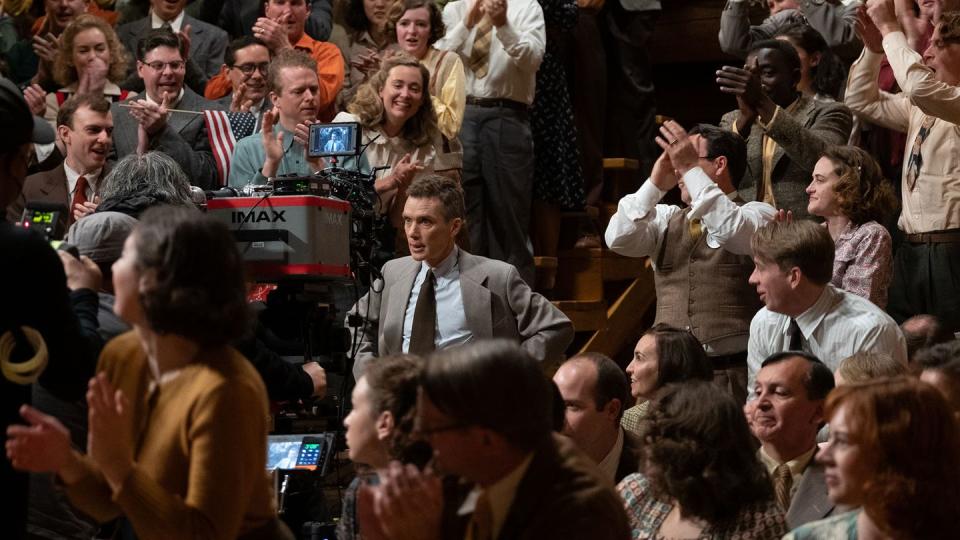The Terrifying—But Irresistible—Power of 'Oppenheimer'

Short of Tom Cruise, there’s been no more vocal advocate for the theatrical experience than Christopher Nolan in recent years. He’s penned impassioned op-eds, battled with studios over release strategy, and his movies have consistently boosted the box office's bottom line. Nolan, though, is not just a champion of theaters—but one of their greatest beneficiaries. His latest, Oppenheimer, is, if not his best film, certainly among his grandest spectacles—one made many times more powerful if witnessed in the largest, loudest venue possible.
As you might expect in a movie about the father of the atomic bomb, there is a great—and I do mean great—explosion in Oppenheimer. But in this three-hour biopic, it’s not just the booms and blasts that are worthy of IMAX. It is Cillian Murphy’s oceanic eyes bulging out of his chainsmoker’s cheekbones. It is the alien emptiness of the New Mexico desert. And it is, perhaps most of all, Ludwig Göransson’s relentless score. The fireworks in this movie are constant, if not always literal.
You feel them going off even in seemingly minor moments. For instance: Early in the film, when a young J. Robert Oppenheimer (Murphy, giving a career performance) observes a Picasso painting. The scene is barely even a scene; it's more of a montage fragment. But as this wunderkind takes in this masterpiece, you glean the primary point Nolan wants to make about his subject: That Oppenheimer’s perception of the world was inherently Cubist. Which is to say that Oppenheimer was simultaneously able to see a subject’s many different angles—and this ability allowed him to justify his sometimes dubious, ultimately world-shaking actions.
If the painting, though, is an early window into Oppenheimer’s kaleidoscopic mind, it’s also an approximation of the film’s nonlinear structure. Nolan never met a clock he didn’t think would benefit from multiple dials, and Oppenheimer certainly employs some of Cubism’s disjointedness as it jumps across timelines. Nolan distinguishes different periods through the use of color (the bulk of the narrative) and black-and-white (Oppenheimer antagonist Lewis Strauss’s 1959 cabinet confirmation hearing).
For the most part, all the time-jumping doesn’t inspire confusion, and rather contributes to the film’s athletic pacing. Oppenheimer’s third act revolves around a pair of hearings: one, in 1954, over whether to renew Oppenheimer’s security clearance; and the other, over Strauss’s (Robert Downey Jr., your 2024 Best Supporting Actor) confirmation. Nolan sprinkles the various depositions earlier in the film as narration. We hear different characters describe why Oppenheimer was eventually chosen to run the Manhattan Project (his unparalleled genius at theoretical physics) despite being a risky choice for the position (his womanizing, plus his flirtations with communism).
Along the way, Nolan’s technique brought to mind another early 20th century master of modern art: Jackson Pollock. Oppenheimer is immense, assaultive, and full of eye-enveloping abstraction. It’s these qualities that allow the director to pull off an exceedingly difficult task: Making complex theory cinematic. Nolan doesn’t spend much time on the nitty-gritty of fusion and fission, and instead conjures these ideas’ sublimity with quick cuts to dazzling depictions of particles, stars, and light. It’s during these moments when Göransson’s score is loudest, thrumming with the at once frightening and exciting momentum of world-shaking ideas.
For all its experimental flourishes, though, if you rearranged Oppenheimer in a chronological order, you’d be left with a fairly traditional biopic. The film’s underlying conventionality is most glaring in its use of lofty dialogue to characterize—and mythologize—its complicated hero. Characters constantly tell Oppenheimer things like, “You’re not just self-important, you’re actually important” and “Robert, you see beyond the world we live in. Of course we’ll help you.” My favorite, though, is: “How could the man who saw so much be so blind?”

In Nolan’s framing, naivete is Oppenheimer’s fatal flaw. He underestimated the ill-intentions of other people, or he overstated how much smarter he was than them. And in the film’s final hour, he learns his lesson the hard way. Following the successful Trinity Test, Truman drops the atom bomb on Hiroshima and Nagasaki, and we glimpse the emotional fallout of Oppenheimer’s incredible achievement—the feelings of guilt, suppression of feeling, and the intellectual rationalizations. “I feel that I have blood on my hands,” Oppenheimer tells President Truman (a hammy Gary Oldman) when he visits the Oval Office. Nolan hammers this feeling home, literalizing the internal detonation during adulatory public appearances. Later, we see Oppenheimer imagining the victims. But in a critical omission, Nolan never shows the devastation to the viewer—a choice that shrouds the violence, leaving it almost theoretical. The urge to keep the focus on Oppenheimer is understandable, but in this instance is a disservice; it makes it too easy for a Western audience to make their own rationalizations.
Overall, Oppenheimer is a sympathetic, though not altogether uncritical, portrait. Nolan, who has called Oppenheimer “the most important person who ever lived,” is clearly enamored by his subject’s mind, charisma, and appearance. In his baggy, high-waisted pants and soft-brimmed hat, Murphy cuts a striking figure. Though, it’s not just him. Like all Nolan movies, Oppenheimer is consumed with a classical handsomeness. Hoyte Van Hoytema’s elegant compositions lend a warranted import to these events. But while visually stunning, the film’s serious aesthetic has one downside: It counteracts the inherent camp of Florence Pugh’s Jean Tatlock (an early love), making Oppenheimer quote the Bhagavad-Gita during sex.
The passage she opens to is, “Now I am become Death, the destroyer of worlds.” The passage reverberates in Oppenheimer’s mind during the Trinity Test. That explosion, Oppenheimer suggests, is the crowning achievement of Oppenheimer’s life’s work. It’s also the zenith of this film. Nolan orchestrates it like a world-class conductor, producing an orgasmic symphony of awe, wonder, and catastrophic power. It’s terrifying, but also irresistible. As such, it brings you closer to understanding Oppenheimer: Who doesn’t want to play God for a moment?
You Might Also Like


